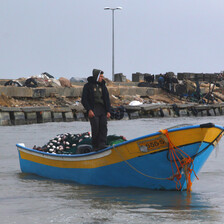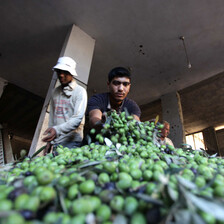The Electronic Intifada 15 February 2010

One of many destroyed water wells in Gaza’s border regions.
“If we didn’t get the wheat planted today, we would not have had crops this year,” says Abu Saleh Abu Taima, eyeing the two Israeli military jeeps parked along the border fence east of Khan Younis, southern Gaza Strip. Although his land is more than 300 meters away, technically outside of the Israeli-imposed “buffer zone,” Abu Taima has reason to be wary.
“They shot at us yesterday. I was here with my wife and nephews.”
Like many farmers along Gaza’s eastern and northern borders, Abu Taima has been delayed planting by the absence of water and the threat from Israeli soldiers along the border.
With most of Gaza’s border region wells, cisterns and water lines destroyed by Israeli forces during last winter’s attacks, farmers have been largely left with no option but to wait for heavier rains.
“Israeli soldiers started intensively bulldozing the land in 2003. But they finished the job in the last war on Gaza,” says Hamdan Abu Taima, owner of 30 dunams (1 dunam is approximate to 1,000 square meters) dangerously close to the buffer zone.
Nasser Abu Taima has 15 dunams of land nearby. Another 15 dunams lie inaccessibly close to the border, rendered off-limits by the Israeli military. “My well was destroyed in the last Israeli war on Gaza. Five years ago I had hothouses for tomatoes, a house here, many trees. It’s all gone. Now I just plant wheat if I can. It’s the simplest.”
Nasser points out the rubble of his home, harvests some ripe cactus fruit and shakes his head. “Such a shame. Such a waste. I knew every inch of this area. Now, I feel sick much of the time because I cannot access my land. And I’ve got 23 in my family to provide for.”
Israel imposed the “buffer zone” along Gaza’s side of the internationally-recognized “Green Line” boundary nearly ten years ago. Israeli bulldozers continue to raze decades-old olive and fruit trees, farmland and irrigation piping, and demolish homes, greenhouses, water wells and cisterns, farm machinery and animal shelters.
Extending from Gaza’s most northwestern to southeastern points, the unclearly-marked buffer zone annexes more land than the 300 meters flanking the border. Israeli authorities say anyone found within risks being shot at by Israeli soldiers. At least 13 Palestinian civilians have been killed and 39 injured in border regions in and outside of the buffer zone since the 18 January end of Israel’s attacks last year, among them children and women.
A sector destroyed

Farmers in southeastern Gaza take shelter from bullets fired by Israeli soldiers at the border nearly one kilometer away.
Ahmed Sourani, of the Palestinian Agricultural Relief Committee (PARC), told the Guardian newspaper: “It is indirect confiscation by fear. My fear is that, if it remains, it will become de facto.”
According to PARC, the fertile farmland in and next to the buffer zone was not long ago Gaza’s food basket and half of Gaza’s food needs were produced within the territory.
In 2008, the agricultural sector employed approximately 70,000 farmers, says PARC, including 30,000 farm laborers earning approximately five dollars per day.
One of the most productive industries some years ago, farming now yields the least and has become one of the most dangerous sectors in Gaza, due to Israeli firing, shelling and aggression against people in the border regions.
Of the 175,000 dunams of cultivable land, PARC reports 60 to 75,000 dunams have been destroyed during Israeli invasions and operations. The level of destruction from the last Israeli war on Gaza alone is vast, with 35 to 60 percent of the agricultural industry destroyed, according to the UN and World Health Organization. Gaza’s sole agricultural college, in Beit Hanoun, was also destroyed.
Oxfam notes that the combination of the Israeli war on Gaza and the buffer zone renders around 46 percent of agricultural land useless or unreachable.
More than 35,000 cattle, sheep and goats were killed during the last Israeli attacks, as well as 1 million birds and chickens, according to a United Nations Environment Programme (UNEP) September 2009 report.
Even before Israel’s last assault, PARC reported on the grave shortage of agricultural needs due to the Israeli siege on Gaza: “saplings, pesticides and fertilizers, plastic sheets for greenhouses and hoses for irrigation are no longer available,” reads its 2008 report.
A March 2009 OCHA report lists nylon, seeds, olive and fruit tree seedlings, plastic piping and valves, fertilizers, animal feed, livestock and many other items as scarce, many of which are “urgently” needed.
The dearth of agricultural goods, combined with Israel’s policies of destruction and aggression in the buffer zone, has meant that farmers have changed practice completely, planting low-maintenance wheat and rye where vegetables and orchards once flourished, or not planting at all.
Water sources were particularly hard hit during Israel’s attack on Gaza last winter.
A UNDP survey following the attacks found that nearly 14,000 dunums of irrigation networks and pipelines have been destroyed, along with 250 wells and 327 water pumps completely damaged, and another 53 wells partially damaged by Israeli bombing and bulldozing. This is excluding the many destroyed cisterns and irrigation ponds.
Farmers now either hand deliver water via plastic jugs or wait for the heavy rains in order to salvage some of their crops. Many others have given up working their land.

Ahmed al-Basiouni: “Now when I water my remaining trees, I do it by hand, tree by tree.”
Farming under fire
Mohammed al-Ibrim, 20, of Benesuhela village near Khan Younis was injured by Israeli shooting in the border region.
“On 18 February 2009, I was working with other farm laborers on land about 500 meters from the border. We’d been working for a couple of hours without problems, and the Israelis had been watching us. Israeli soldiers began shooting from the border as we pushed our pickup truck which had broken down. I was shot in the ankle.”
His injury came just weeks after cousin Anwar al-Ibrim was martyred by an Israeli soldier’s bullet to the neck. Anwar al-Ibrim leaves behind a wife and two infants.
Meanwhile, in Gaza’s north, Ali Hamad, 52, has 18 dunams of land roughly 500 meters from the border east of Beit Hanoun.
“The Israelis bulldozed my citrus trees, water pump, well and irrigation piping in the last war. No one can come here to move the rubble of my well — everyone is afraid of the Israeli soldiers at the border. So now we are just waiting for the winter rains.
All but one well and pump have been destroyed in this region.
“I haven’t watered my few remaining trees since the war. I used to water them once a week, three to four hours per session. Now, they are dehydrated, the lemons and oranges are miniature.”
Mohammed Musleh, 70, lives east of Beit Hanoun, roughly 1.5 kilometers from the border, and owns the only working well and pump in his region.
“There used to be many birds in this area, because it was so fertile, until the Israelis started bulldozing all of the trees, including mine. When people replanted them, the Israelis began destroying the water sources instead.”
Ahmed al-Basiouni, 53, owned the first well established in the east Beit Hanoun area, built in 1961.
“My brothers and I have 60 dunams of land. Many people took water from our well. It was destroyed in 2003, and again in the last Israeli war. Now when I water my remaining trees, I do it by hand, tree by tree.”
In its September 2009 report, the UNEP warned that Gaza’s aquifer is in “serious danger of collapse,” noting that the problem has roots in the “rise in salt water intrusion from the sea caused by over-extraction of ground water.” According to the report, the salinity and nitrate levels of water are far above WHO-accepted levels. Between 90 and 95 percent of the water available to Palestinians in Gaza is contaminated and hence “unfit for human consumption,” according to WHO standards.
Water has been further contaminated by chemical agents used by the Israeli army during its war on Gaza. More contamination from destroyed asbestos roofing, the toxins produced by the bodies of thousands of animal carcasses, and waste sites which were inaccessible and damaged during and after the attacks on Gaza exacerbates the situation.
Further up the lane, Hassan al-Basiouni, 54, says he has lost a quarter of a million dollars to the Israeli land and well destruction.
“My brothers and I have 41 dunams. Our well was destroyed once before this last war. The materials to make a new well aren’t available in Gaza. The 180 people who earned a living off this land are out of work.”
According to Bassiouni, it costs $200 to raise just one fruit tree to fruit bearing maturity.
“We had 1,500 citrus trees, some destroyed in random Israeli shelling and the rest destroyed during the last Israeli war on Gaza. The few remaining trees are only one year old and produce nothing.”
“This water we’re using,” says Basiouni, referring to the contamination, “actually dehydrates the trees.”

Sena and Amar Mhayssy deliver water by hand after Israel destroyed the water sources on their land.
Weathering the storm
In eastern Gaza’s Shejaiye area, Sena, 74, and Amar Mhayssy, 78, are devastated. “Our land has been bulldozed four times. We have nine dunams of land in the buffer zone which we can’t access because the Israelis will shoot at us. We have 10 dunams of land over 500 meters from the border fence. Our olive trees, over 60 years old, were all bulldozed by the Israeli army.”
They persevere in the face of danger and futility.
“Now we’re growing okra and have replanted 40 olive trees. But they will take years before they produce many olives. We need to water the new trees every three days, but our water source was destroyed. So we bring containers to water them. There are 13 people in our family, with four in university. Aside from farming, we have no work.”
In al-Faraheen village, east of Khan Younis, Jaber Abu Rjila now can only work his land on a small scale.
“My chicken farm — over 500 meters from the border — as well as 500 fruit and olive trees and 100 dunams of wheat and peas of my and my neighbors’ land were destroyed in May 2008 by Israeli bulldozers. My cistern, the pump and motor and one of my tractors were destroyed. The side of our house facing the border is filled with bullet holes from the Israeli soldiers. Now, because of the danger we rent a home half a kilometer away. I’ve lost my income, how can I pay for rent?”
Since the first constraints of the siege on Gaza were imposed nearly four years ago, the destruction of Gaza’s agricultural sector and potential to provide produce and economy to a severely undernourished Strip has dramatically worsened.
With Palestinians in Gaza now largely dependent on the expensive Israeli produce that is inconsistently allowed into Gaza, the plight of the farmers reverberates throughout the population.
All images by Eva Bartlett.
Eva Bartlett is a Canadian human rights advocate and freelancer who arrived in Gaza in November 2008 on the third Free Gaza Movement boat. She has been volunteering with the International Solidarity Movement and documenting Israel’s ongoing attacks on Palestinians in Gaza. During Israel’s recent assault on Gaza, she and other ISM volunteers accompanied ambulances and documenting the Israeli attacks on the Gaza Strip.




